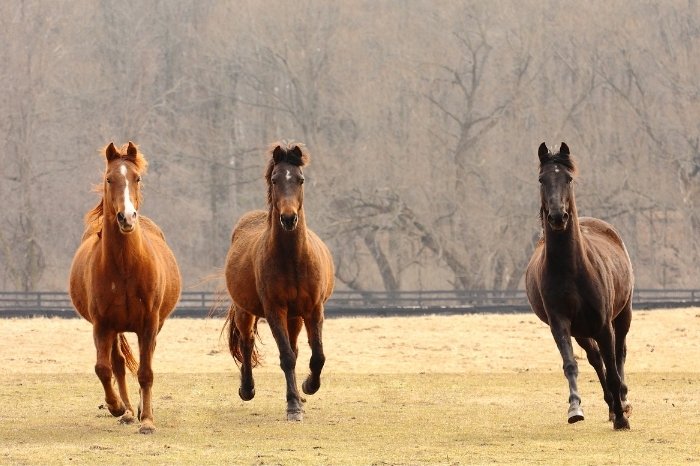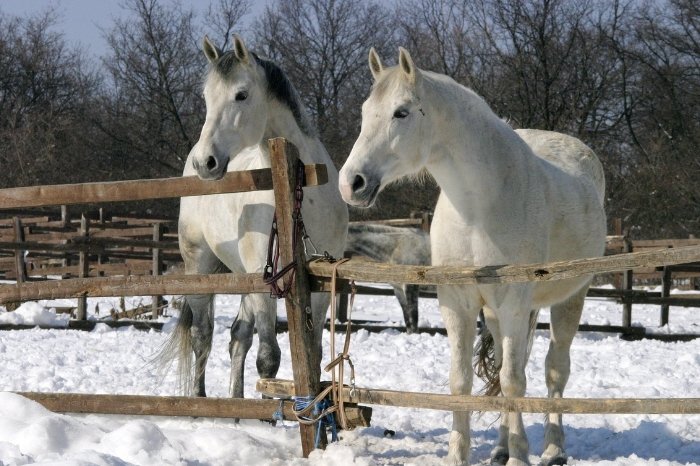Last Updated on February 1, 2022
Go to any racecourse or racing stables and you will see that Thoroughbreds are mostly black, bay, chestnut, or brown. You might occasionally see a gray Thoroughbred, but overall the coloring of this breed is fairly basic. But did you know that you can get a dominant white Thoroughbred horse as well?!
The science behind horse coloring is very complex, and to understand how we get a white horse we need to know a bit more about the basic horse color genes. Let’s find out more about dominant white Thoroughbred horses!
What Color Are Thoroughbred Horses?
Some breeds of horses come in a huge range of colors. For example, there are 23 different colors of Quarter Horse recognized by the American Quarter Horse Association.
However, when it comes to Thoroughbreds, they come in just 8 different colors! These are:
- Black
- Bay
- Brown
- Chestnut
- Palomino
- Gray
- Roan
- White

Of these colors, some are much more prevalent than others. Bay, chestnut, and gray are the most common colors of Thoroughbred, while it is less likely that you will see a black, palomino, or roan Thoroughbred horse. White Thoroughbred horses are the rarest of all the colors.
What Determines The Color Of A Horse?
Interestingly, all horses are based on two basic colors – black and red (chestnut). Each horse inherits either a black or red gene from each parent, which determines the basic coat color. Two black genes will create a black horse, two red genes give us a chestnut, and one of each results in a bay horse.
So, if a horse has only these basic genes, its color will be black, bay, or chestnut. It is only when the parents also carry other color-changing genes that we start to see different colors and markings emerging.
For example, some horses carry color dilution genes. These have the effect of lightening the pigment of the base coat color, and they all act in different ways. For a Thoroughbred to be palomino colored, it will need to inherit the cream dilution gene from one of its parents.
Gray coat coloring occurs when a horse inherits the gray gene from one or both of its parents. This is a dominant gene, that overrules all other color influencing genes. However, gray horses are not born this way – as a foal, they will have their basic coloring, which will fade to gray over time.
What Is A Dominant White Thoroughbred Horse?
A dominant white Thoroughbred horse is one that has inherited a specific gene from one or both parents that creates white coloring. In a white horse, the skin will appear pink, as it has no pigmentation. The eyes of a white horse are usually dark, unlike other similar coat colorings.
A horse that has dominant white genes may be white all over its body, or it can have patches of darker hair that reflect the base coat color and any other color-changing genes. The skin under this dark hair will also be white.
Read more about Grey Horse Color – Why Do Some Horses Turn Grey?
What Makes A Dominant White Thoroughbred So Special?
A white Thoroughbred foal is so rare that the birth of one will often make the headlines! These bloodlines are very rare, but fans of this color are beginning to understand how to breed more white horses of this breed. So, in the future, we might see many more winning Thoroughbred horses on the race track!
It is easy to confuse a white Thoroughbred with other coat colors. As a gray horse gets older, its coat will fade to almost white. However, the skin color will remain dark, unlike the pink skin of a white horse.
In other breeds, there are many colorings that can be confused with dominant white markings. Other genes that result in white patches on the coat include Appaloosa, Sabino 1, Splashed White, Tobiano, and Overo. The difference between these genes lies in the size and distribution of the white markings.
Dominant white markings can also occur from a spontaneous genetic mutation. This means that the horse has no direct ancestors that carry this gene but may be born with a splash of white coloring on a solid base coat.
Check Out The Top 5 White Horse Breeds
Horse Coloring Amazing Facts
- There are no albino horses! The genetic factors required for albinism do not exist in horses.
- Horses have six different dilution genes, that will all lighten the coat in different ways. They are Cream, Champagne, Dun, Pearl, Silver, and Mushroom.
- Some horses have ‘primitive markings’, which are associated with ancient breeds of horses. These include the dorsal stripe seen on dun horses, as well as shoulder stripes and leg barring.
- Many Akhal-Teke horses have a spectacular metallic sheen to the coat. The genetics behind this amazing color is not yet fully understood, but this coloring is a highly desirable trait in the breed.

Dominant White Thoroughbred Summary
So, as we have learned, when a Thoroughbred horse inherits the dominant white gene it will have white patches over its body. It may even be completely white, although this coloring is very rare.
We’d love to hear your thoughts on dominant white Thoroughbred horses! Leave a comment below and we’ll get back to you.
FAQs

Kate Chalmers is a qualified veterinary nurse who has specialized in horse care for the vast majority of her career. She has been around horses since she was a child, starting out riding ponies and helping out at the local stables before going on to college to study Horse Care & Management. She has backed and trained many horses during her lifetime and competed in various equestrian sports at different levels.
After Kate qualified as a veterinary nurse, she provided nursing care to the patients of a large equine veterinary hospital for many years. She then went on to teach horse care and veterinary nursing at one of the top colleges in the country. This has led to an in-depth knowledge of the care needs of horses and their various medical ailments, as well as a life-long passion for educating horse owners on how to provide the best possible care for their four-legged friends.
Kate Chalmers BSc (Hons) CVN, Dip AVN (Equine) Dip HE CVN EVN VN A1 PGCE

